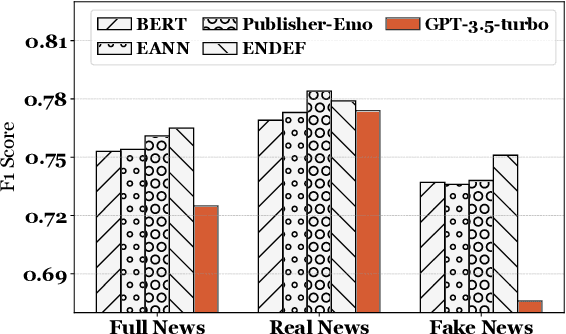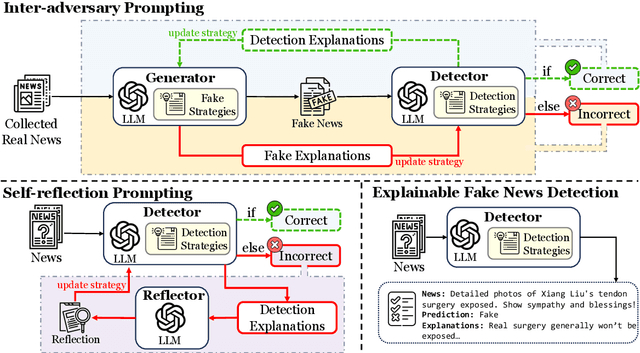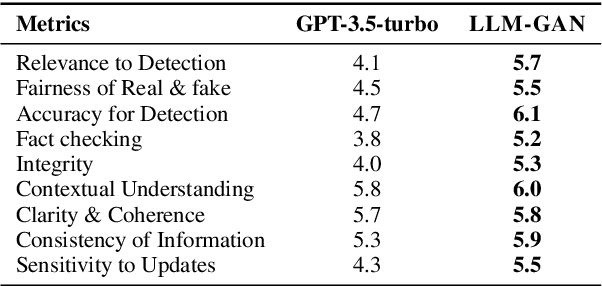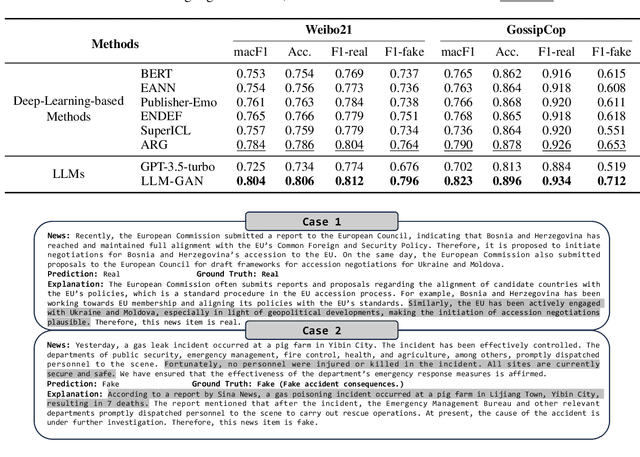Zhouhong Gu
LITE: LLM-Impelled efficient Taxonomy Evaluation
Apr 02, 2025Abstract:This paper presents LITE, an LLM-based evaluation method designed for efficient and flexible assessment of taxonomy quality. To address challenges in large-scale taxonomy evaluation, such as efficiency, fairness, and consistency, LITE adopts a top-down hierarchical evaluation strategy, breaking down the taxonomy into manageable substructures and ensuring result reliability through cross-validation and standardized input formats. LITE also introduces a penalty mechanism to handle extreme cases and provides both quantitative performance analysis and qualitative insights by integrating evaluation metrics closely aligned with task objectives. Experimental results show that LITE demonstrates high reliability in complex evaluation tasks, effectively identifying semantic errors, logical contradictions, and structural flaws in taxonomies, while offering directions for improvement. Code is available at https://github.com/Zhang-l-i-n/TAXONOMY_DETECT .
RECKON: Large-scale Reference-based Efficient Knowledge Evaluation for Large Language Model
Apr 01, 2025Abstract:As large language models (LLMs) advance, efficient knowledge evaluation becomes crucial to verifying their capabilities. Traditional methods, relying on benchmarks, face limitations such as high resource costs and information loss. We propose the Large-scale Reference-based Efficient Knowledge Evaluation for Large Language Model (RECKON), which directly uses reference data to evaluate models. RECKON organizes unstructured data into manageable units and generates targeted questions for each cluster, improving evaluation accuracy and efficiency. Experimental results show that RECKON reduces resource consumption by 56.5% compared to traditional methods while achieving over 97% accuracy across various domains, including world knowledge, code, legal, and biomedical datasets. Code is available at https://github.com/MikeGu721/reckon
ToReMi: Topic-Aware Data Reweighting for Dynamic Pre-Training Data Selection
Apr 01, 2025Abstract:Pre-training large language models (LLMs) necessitates enormous diverse textual corpora, making effective data selection a key challenge for balancing computational resources and model performance. Current methodologies primarily emphasize data quality metrics and mixing proportions, yet they fail to adequately capture the underlying semantic connections between training samples and quality disparities within individual domains. We introduce ToReMi (Topic-based Reweighting for Model improvement), a novel two-stage framework that dynamically adjusts training sample weights according to their topical associations and observed learning patterns. Our comprehensive experiments reveal that ToReMi variants consistently achieve superior performance over conventional pre-training approaches, demonstrating accelerated perplexity reduction across multiple domains and enhanced capabilities on downstream evaluation tasks. Code is available at https://github.com/zxx000728/ToReMi.
GAPO: Learning Preferential Prompt through Generative Adversarial Policy Optimization
Mar 26, 2025Abstract:Recent advances in large language models have highlighted the critical need for precise control over model outputs through predefined constraints. While existing methods attempt to achieve this through either direct instruction-response synthesis or preferential response optimization, they often struggle with constraint understanding and adaptation. This limitation becomes particularly evident when handling fine-grained constraints, leading to either hallucination or brittle performance. We introduce Generative Adversarial Policy Optimization (GAPO), a novel framework that combines GAN-based training dynamics with an encoder-only reward model to progressively learn and adapt to increasingly complex constraints. GAPO leverages adversarial training to automatically generate training samples of varying difficulty while utilizing the encoder-only architecture to better capture prompt-response relationships. Extensive experiments demonstrate GAPO's superior performance across multiple benchmarks, particularly in scenarios requiring fine-grained constraint handling, where it significantly outperforms existing methods like PPO, DPO, and KTO. Our results suggest that GAPO's unique approach to preferential prompt learning offers a more robust and effective solution for controlling LLM outputs. Code is avaliable in https://github.com/MikeGu721/GAPO.
PII-Bench: Evaluating Query-Aware Privacy Protection Systems
Feb 25, 2025Abstract:The widespread adoption of Large Language Models (LLMs) has raised significant privacy concerns regarding the exposure of personally identifiable information (PII) in user prompts. To address this challenge, we propose a query-unrelated PII masking strategy and introduce PII-Bench, the first comprehensive evaluation framework for assessing privacy protection systems. PII-Bench comprises 2,842 test samples across 55 fine-grained PII categories, featuring diverse scenarios from single-subject descriptions to complex multi-party interactions. Each sample is carefully crafted with a user query, context description, and standard answer indicating query-relevant PII. Our empirical evaluation reveals that while current models perform adequately in basic PII detection, they show significant limitations in determining PII query relevance. Even state-of-the-art LLMs struggle with this task, particularly in handling complex multi-subject scenarios, indicating substantial room for improvement in achieving intelligent PII masking.
LLM-GAN: Construct Generative Adversarial Network Through Large Language Models For Explainable Fake News Detection
Sep 03, 2024



Abstract:Explainable fake news detection predicts the authenticity of news items with annotated explanations. Today, Large Language Models (LLMs) are known for their powerful natural language understanding and explanation generation abilities. However, presenting LLMs for explainable fake news detection remains two main challenges. Firstly, fake news appears reasonable and could easily mislead LLMs, leaving them unable to understand the complex news-faking process. Secondly, utilizing LLMs for this task would generate both correct and incorrect explanations, which necessitates abundant labor in the loop. In this paper, we propose LLM-GAN, a novel framework that utilizes prompting mechanisms to enable an LLM to become Generator and Detector and for realistic fake news generation and detection. Our results demonstrate LLM-GAN's effectiveness in both prediction performance and explanation quality. We further showcase the integration of LLM-GAN to a cloud-native AI platform to provide better fake news detection service in the cloud.
StrucText-Eval: An Autogenerated Benchmark for Evaluating Large Language Model's Ability in Structure-Rich Text Understanding
Jun 30, 2024Abstract:Given the substantial volumes of structured data held by many companies, enabling Large Language Models (LLMs) to directly understand structured text in non-structured forms could significantly enhance their capabilities across various business scenarios. To this end, we propose evaluation data generation method for assessing LLM's ability in understanding the structure-rich text, which generates structured data of controllable complexity based on manually crafted question templates and generation rules. Building on this generation method, we introduce StrucText-Eval, a benchmark comprising 6,032 questions across 8 different structured languages and 29 specific tasks. Furthermore, considering human proficiency in rule-based tasks, we also present StrucText-Eval-Hard, which includes 3,016 questions designed to further examine the gap between LLMs and human performance. Results indicate that the best-performing LLM currently achieve an accuracy of 65.0\% on StrucText-Eval-Hard, while human accuracy reaches up to 95.7\%. Moreover, while fine-tuning using StrucText-Eval can enhance existing LLMs' understanding of all structured languages, it does not necessarily improve performance across all task types. The benchmark and generation codes are open sourced in https://github.com/MikeGu721/StrucText-Eval
DetectBench: Can Large Language Model Detect and Piece Together Implicit Evidence?
Jun 18, 2024



Abstract:Detecting evidence within the context is a key step in the process of reasoning task. Evaluating and enhancing the capabilities of LLMs in evidence detection will strengthen context-based reasoning performance. This paper proposes a benchmark called DetectBench for verifying the ability to detect and piece together implicit evidence within a long context. DetectBench contains 3,928 multiple-choice questions, with an average of 994 tokens per question. Each question contains an average of 4.55 pieces of implicit evidence, and solving the problem typically requires 7.62 logical jumps to find the correct answer. To enhance the performance of LLMs in evidence detection, this paper proposes Detective Reasoning Prompt and Finetune. Experiments demonstrate that the existing LLMs' abilities to detect evidence in long contexts are far inferior to humans. However, the Detective Reasoning Prompt effectively enhances the capability of powerful LLMs in evidence detection, while the Finetuning method shows significant effects in enhancing the performance of weaker LLMs. Moreover, when the abilities of LLMs in evidence detection are improved, their final reasoning performance is also enhanced accordingly.
StructBench: An Autogenerated Benchmark for Evaluating Large Language Model's Ability in Structure-Rich Text Understanding
Jun 15, 2024Abstract:Given the substantial volumes of structured data held by many companies, enabling Large Language Models (LLMs) to directly understand structured text in non-structured forms could significantly enhance their capabilities across various business scenarios. To this end, we propose evaluation data generation method for assessing LLM's ability in understanding the structure-rich text, which generates structured data of controllable complexity based on manually crafted question templates and generation rules. Building on this generation method, we introduce StructBench, a benchmark comprising 6,032 questions across 8 different structured languages and 29 specific tasks. Furthermore, considering human proficiency in rule-based tasks, we also present StructBench-Hard, which includes 3,016 questions designed to further examine the gap between LLMs and human performance. Results indicate that the best-performing LLM currently achieve an accuracy of 65.0\% on StructBench-Hard, while human accuracy reaches up to 95.7\%. Moreover, while fine-tuning using StructBench can enhance existing LLMs' understanding of all structured languages, it does not necessarily improve performance across all task types. The benchmark and generation codes are open sourced in https://github.com/MikeGu721/StructBench
Agent Group Chat: An Interactive Group Chat Simulacra For Better Eliciting Collective Emergent Behavior
Mar 20, 2024Abstract:To investigate the role of language in human collective behaviors, we developed the Agent Group Chat simulation to simulate linguistic interactions among multi-agent in different settings. Agents are asked to free chat in this simulation for their own purposes based on their character setting, aiming to see agents exhibit emergent behaviours that are both unforeseen and significant. Four narrative scenarios, Inheritance Disputes, Law Court Debates, Philosophical Discourses, Movie Casting Contention, are integrated into Agent Group Chat to evaluate its support for diverse storylines. By configuring specific environmental settings within Agent Group Chat, we are able to assess whether agents exhibit behaviors that align with human expectations. We evaluate the disorder within the environment by computing the n-gram Shannon entropy of all the content speak by characters. Our findings reveal that under the premise of agents possessing substantial alignment with human expectations, facilitating more extensive information exchange within the simulation ensures greater orderliness amidst diversity, which leads to the emergence of more unexpected and meaningful emergent behaviors. The code is open source in https://github.com/MikeGu721/AgentGroup, and online platform will be open soon.
 Add to Chrome
Add to Chrome Add to Firefox
Add to Firefox Add to Edge
Add to Edge